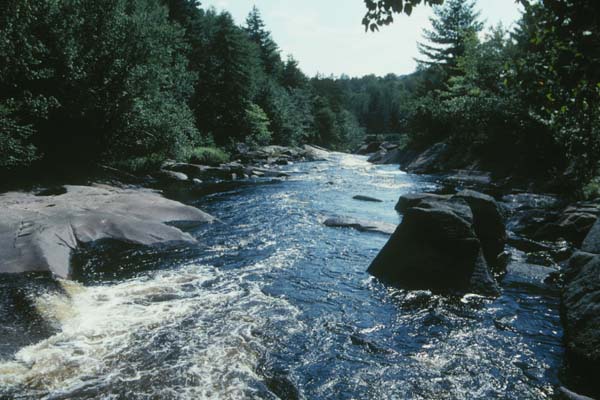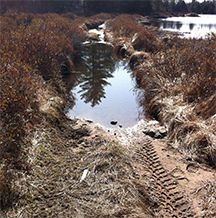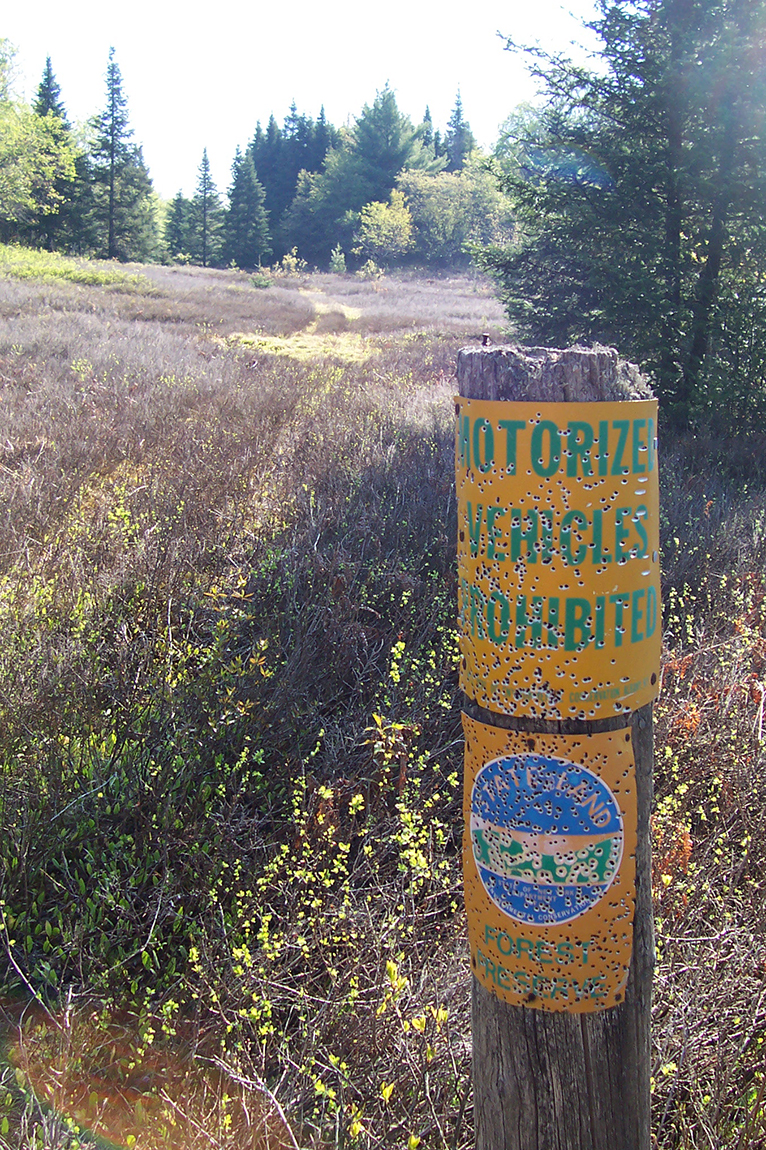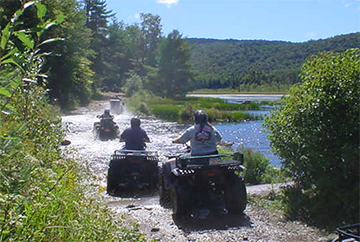
New York takes a U-turn on ATVs in the Adirondacks
Written by: Kevin Chlad - Adirondack Council Director of Government Relations
Wednesday, March 1, 2017

South Branch of the Grass RiverIn September of last year, Governor Cuomo’s Adirondack Park Agency (APA) released the Department of Environmental Conservation’s (DEC) Grass River Unit Management Plan (UMP) for public comment, which if approved would permit public All-Terrain Vehicle (ATV) use on the Adirondack Forest Preserve. This proposed action would run contrary to the policy of the last three administrations, and appears to overlook strong science and mountains of evidence that suggest that sturdy policies are needed before the state considers any further ATV riding opportunities on public lands. For 125 years, New York has been a global leader when it comes to resource protection policies and stewardship of our state lands in the Adirondacks. This policy shift by Governor Cuomo’s state agencies represents an emerging threat to our Adirondack legacy.
The Grass River UMP proposal does not represent the full extent of the state’s recent expansion of inappropriate motorized uses. The state also recently approved the Recreation Management Plan for the Kushuqua Conservation Easement, located in south-central Franklin County adjacent to the Debar Mountain Wild Forest, which opened up 30 miles of roads on the property to seasonal ATV use. The St. Lawrence Flatlands Unit Management Plan, which provides an essential wildlife migration corridor between the Adirondacks and Canada, opened ATV riding opportunities on lands where trails had already been closed due to misuse once before.
So how exactly does the Governor’s current trajectory on ATVs differ from his predecessors?
 In 2003, the Department of Environmental Conservation (DEC), under then-Governor George Pataki, filed a lawsuit against the Town of Horicon after the town board opened a series of abandoned town roads on the Adirondack Forest Preserve to public ATV traffic. The illegal road openings resulted in heavy damage to state property and forced quiet recreationists to look elsewhere for places to enjoy. Under state law, only one road in Horicon is legally available to ATV riders and it is designated for use only by those with disabled-access permits. The case was finally decided by the Appellate Division of the New York State Supreme Court, in favor of the state, then led by Attorney General Andrew M. Cuomo.
In 2003, the Department of Environmental Conservation (DEC), under then-Governor George Pataki, filed a lawsuit against the Town of Horicon after the town board opened a series of abandoned town roads on the Adirondack Forest Preserve to public ATV traffic. The illegal road openings resulted in heavy damage to state property and forced quiet recreationists to look elsewhere for places to enjoy. Under state law, only one road in Horicon is legally available to ATV riders and it is designated for use only by those with disabled-access permits. The case was finally decided by the Appellate Division of the New York State Supreme Court, in favor of the state, then led by Attorney General Andrew M. Cuomo.
In 2004, DEC Commissioner Erin Crotty closed all Forest Preserve roads to ATV Traffic, citing excessive damage to the roads and off-road areas throughout the Park. Later that year, Commissioner Crotty ofï¬cially began enforcement of road closures in four western Adirondack Wild Forests where ATV trafï¬c had caused widespread damage to the forests and to state property (signs, fences, barriers, etc.). The ban on ATVs included the Aldrich Pond, Independence River and Black River and Watsonʼs East Wild Forests, limiting public ATV access on a total of 54 roads in the four areas. The DEC concluded that all such roads should be closed to unlimited ATV access by the general public. Environmental Conservation Ofï¬cers and Forest Rangers closely monitored ATV access and enforced the new rules.
|
While Governor Cuomo’s contrast with recent administrations on ATVs is confusing, his contrast with his own administration and public officers is frustrating. Our Rangers protect five-million acres of state lands, more than 900,000 acres of conservation easement lands and the people who use these lands on a regular basis. They have a 365 day-a-year, 24 hour responsibility, interacting with the public who use our state resources, keeping us safe through education, enforcement, and when necessary, by rescue. Their 2015 Ranger report highlighted illegal ATV operation as their “most problematic activity.” The DEC issued an annual average of 538 tickets for illegal ATV operation over the last decade. The 2011 NYSDEC Strategic Plan for State Forest Management, published under the leadership of Commissioner Joe Martens and during Governor Cuomo’s tenure, details the inappropriate nature of recreational ATV riding on our state-owned lands: Environmental impacts from ATV and off-highway vehicle (OHV) use include soil erosion, displacement and compaction, direct impacts to streams and wetlands from ATV crossings, including increased siltation and turbidity, noise, disturbance to wildlife and their habitats, damage to vegetation, and air pollution. ATV use impacts neighboring landowners and conflicts with other recreational pursuits. Illegal use of ATVS and OHVs on State Forest roads and trails officially closed to ATV and OHV use is frequent, difficult to prevent, and presents significant enforcement issues. Despite a variety of signs, gates, boulders, and other barriers designed to notify ATV and OHV users that particular roads and trails are closed to their use, a large amount of illegal riding continues to occur on these prohibited areas… The environmental impacts (including noise), intensity, and nature of both legal and illegal ATV use has been shown to cause other recreational uses to decline and in some cases completely cease, once an area is opened for ATV use. Over the years, attempts have been made to accommodate offhighway and all-terrain vehicle use on several State Forests but in each case, the use was not sustainable. Serious issues with soil erosion, illegal off-trail use and rutting developed. In all cases DEC was not able to find acceptable ways to mitigate the impacts, even when organized user groups were included in the process. In the end, each of the former off-road vehicle trail systems was closed. (NYSDEC Strategic Plan for State Forest Management, Page 213) This section of the strategic plan goes on to highlight a number of case studies demonstrating failed attempts to permit ATV use on state lands. One of these examples involves land opened again recently to ATV use in the St Lawrence Flatlands UMP.
The Grass River UMP should be changed to eliminate ATV use and the state should move forward with instituting a general ban of ATV use on state lands. |
|
Would you like to comment on what you've read or viewed? We'd love to hear from you. Please click to send us a message.
|
|||

 In March 2005, then-Acting DEC Commissioner Denise Sheehan issued a new policy clarifying that none of the Adirondack Forest Preserve was suitable for riding ATVs and that the activity would be banned. The only exceptions would be for short distances across areas of the Forest Preserve between two tracts of private land where the state already owns a conservation easement allowing ATV use; for individuals with disabilities; and, for existing rights of way to private lands. Following the Pataki administration, Governors Spitzer and Patterson honored and upheld Commissioner Sheehan’s policy, later enforced by Commissioner Pete Grannis.
In March 2005, then-Acting DEC Commissioner Denise Sheehan issued a new policy clarifying that none of the Adirondack Forest Preserve was suitable for riding ATVs and that the activity would be banned. The only exceptions would be for short distances across areas of the Forest Preserve between two tracts of private land where the state already owns a conservation easement allowing ATV use; for individuals with disabilities; and, for existing rights of way to private lands. Following the Pataki administration, Governors Spitzer and Patterson honored and upheld Commissioner Sheehan’s policy, later enforced by Commissioner Pete Grannis. The data from the Ranger report, when combined with the evidence from the Strategic Plan for State Forest Management represents an unacceptable level of misuse of Forest Preserve lands. When considered within a strong scientific context, the Governor and his state agencies should clearly land upon the conclusion that illegal operation of ATVs is currently out of control, and should not be permitted as a sanctioned activity on state lands. History shows that this is was the conclusion reached by Commissioners Crotty, Sheehan, Grannis and Martens, and supported by Governor’s Pataki, Spitzer and Patterson. Will our current administration ultimately reach the same conclusion, or will they part ways with the facts, strong science and our Adirondack legacy?
The data from the Ranger report, when combined with the evidence from the Strategic Plan for State Forest Management represents an unacceptable level of misuse of Forest Preserve lands. When considered within a strong scientific context, the Governor and his state agencies should clearly land upon the conclusion that illegal operation of ATVs is currently out of control, and should not be permitted as a sanctioned activity on state lands. History shows that this is was the conclusion reached by Commissioners Crotty, Sheehan, Grannis and Martens, and supported by Governor’s Pataki, Spitzer and Patterson. Will our current administration ultimately reach the same conclusion, or will they part ways with the facts, strong science and our Adirondack legacy? Kevin joined the Adirondack Council staff in 2011.
Kevin joined the Adirondack Council staff in 2011.


